Recent Posts
How to Get Rid of Musty Smells In Your House
7/17/2024 (Permalink)
A musty smell in your home can be quite unpleasant and often signals underlying issues. Fortunately, getting rid of musty odors is a manageable task with a few strategic steps. As experts in restoration and cleaning, SERVPRO® is here to guide you through the process to ensure your home smells fresh and clean once again.
Identify the Source
Before you can eliminate musty odors, it's crucial to pinpoint their origin. Common sources include damp basements, hidden mold growth, or water leaks. Check areas that are prone to moisture, such as bathrooms, kitchens, basements, and laundry rooms. Look for signs of water damage or mold, which often accompany musty smells.
Dry Out the Area
Moisture is often the primary cause of musty odors, so drying out the affected area is essential. Use dehumidifiers to reduce humidity levels, particularly in damp areas like basements and bathrooms. Ensure proper ventilation by opening windows and using exhaust fans to help circulate air and speed up the drying process.
Clean and Disinfect
Once the area is dry, the next step is to clean and disinfect. Use a mixture of water and white vinegar or a commercial cleaner to scrub surfaces that may harbor mold or mildew. Pay special attention to hidden spots such as under sinks, behind appliances, and inside closets. For carpets and upholstery, consider using a steam cleaner to penetrate deep into fibers and eliminate any trapped odors.
Use Odor Absorbers
To further neutralize musty smells, place odor absorbers around your home. Baking soda, activated charcoal, and white vinegar are excellent natural options. Simply place bowls of these substances in areas where odors are present. They will help absorb and neutralize lingering smells over time. Additionally, using air purifiers with HEPA filters can help remove airborne particles that contribute to odors.
Inspect and Maintain HVAC Systems
Your HVAC system can also be a culprit in spreading musty odors throughout your home. Regularly change air filters and have your HVAC system inspected and cleaned by professionals. Duct cleaning services can remove dust, mold, and other contaminants that contribute to musty smells.
Regular Maintenance and Prevention
Preventing musty odors requires regular home maintenance. Ensure your home is well-ventilated, particularly in high-moisture areas. Regularly inspect and repair any leaks in your plumbing or roof to prevent water damage. Consider using moisture barriers in basements and crawl spaces to reduce humidity levels. Keep your home clean and dry to prevent mold and mildew from developing.
Seek Professional Help When Needed
If the musty smell persists despite your efforts, it might be time to seek professional assistance. SERVPRO offers comprehensive cleaning and restoration services to address the underlying issues causing musty odors. Our team of experts can thoroughly inspect your home, identify problem areas, and provide effective solutions to eliminate odors and prevent future occurrences.
By following these steps, you can successfully rid your home of musty smells and create a more pleasant living environment. For more expert advice or assistance with odor removal, contact SERVPRO today. We are here to help you restore and maintain a fresh, clean home.
Water Damage in Commercial Kitchens: Recovery and Clean-Up Tips
6/12/2024 (Permalink)
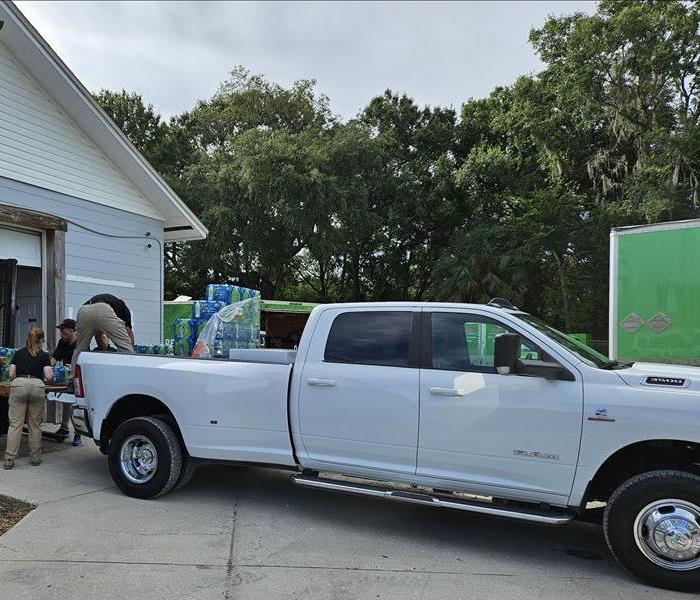 With the right knowledge and prompt action, you can minimize the downtime and get your commercial kitchen up and running again.
With the right knowledge and prompt action, you can minimize the downtime and get your commercial kitchen up and running again.
Accidents happen, and in the fast-paced environment of a commercial kitchen, water damage is a common occurrence. Whether it's a burst pipe, a leaky dishwasher, or flooding from heavy rain, water damage can disrupt your business operations and lead to costly repairs. However, with the right knowledge and prompt action, you can minimize the downtime and get your commercial kitchen up and running again.
Identify the Source of the Water Damage
The first step in addressing water damage is to identify the source. Quickly locate and shut off the water supply to prevent further damage. Common sources of water damage in commercial kitchens include faulty plumbing, damaged appliances, and weather-related incidents. By identifying the source, you can better understand the extent of the damage and take appropriate action.
Prioritize Safety
Before entering the affected area, make sure it is safe to do so. If there are any electrical appliances, turn off the power immediately to avoid the risk of electrocution. In case of severe flooding, it may be necessary to evacuate the premises until professional help arrives.
Contact a Professional Commercial Restoration Service
Commercial water damage requires professional expertise to ensure thorough and efficient recovery. Contact a reputable commercial restoration service like SERVPRO® as soon as possible. SERVPRO specializes in commercial water damage restoration and can help you with the cleanup process, minimizing the impact on your business.
Document the Damage and Notify Insurance
Take photos and videos of the water damage before any restoration work begins. This documentation will be useful when filing an insurance claim. Notify your insurance company promptly to begin the claim process and ensure that you have all the necessary paperwork in order.
Remove Standing Water
If it is safe to do so, begin the water extraction process to remove standing water from the affected areas. Use mops, buckets, or wet vacuums to remove as much water as possible. The faster you can remove the water, the lower the risk of secondary damage, such as mold growth.
Dry and Dehumidify
After water extraction, it is crucial to thoroughly dry the affected areas using industrial-grade fans and dehumidifiers. This step is essential to prevent the growth of mold and mildew, which can pose health risks to occupants and cause further damage to your commercial kitchen.
Clean and Sanitize
Once the affected areas are dry, cleaning and sanitization are necessary to ensure a safe and hygienic environment. Use commercial-grade cleaning products to remove any remaining contaminants and bacteria. Pay special attention to hard-to-reach areas, such as corners and crevices, where mold can easily thrive.
Repair and Restore
Once the cleanup process is complete, it's time to repair and restore any damaged structures, equipment, or fixtures. A professional commercial restoration service like SERVPRO® will have the expertise and resources to handle repairs efficiently, getting your commercial kitchen back to its original state.
Prevention is Key
To minimize the risk of future water damage, it's essential to implement preventative measures. Regularly inspect plumbing systems, appliances, and the building's exterior for any signs of damage or deterioration. Promptly address any leaks or issues to prevent them from escalating into larger problems.
In conclusion, water damage in commercial kitchens can disrupt your business and cause significant financial loss. By following these recovery and clean-up tips, along with the assistance of a professional commercial restoration service like SERVPRO, you can mitigate the damage and restore your commercial kitchen quickly. Remember, acting promptly is crucial in preventing secondary issues like mold growth. Don't hesitate to reach out to expert help for efficient and reliable commercial water damage restoration services.
Everything You Need to Know About Coastal Flooding and Storm Surge
5/15/2024 (Permalink)
Coastal flooding and storm surge are significant concerns for residents living in coastal areas, especially during hurricane season. Understanding these phenomena is crucial for homeowners to adequately prepare and protect their properties. Let's delve into the basics of coastal flooding and storm surge to shed light on these natural hazards.
What is Coastal Flooding?
Coastal flooding occurs when water from the ocean inundates coastal areas, often due to a combination of factors such as heavy rainfall, high tides, and storm surges. It can lead to extensive property damage, erosion of beaches and dunes, and pose risks to life and safety. Coastal flooding is a common occurrence during hurricanes, tropical storms, and nor'easters, making it essential for coastal residents to be prepared.
Understanding Storm Surge
Storm surge is a significant contributor to coastal flooding during severe weather events, particularly hurricanes. It refers to the abnormal rise in seawater level along the coast caused by the strong winds and low atmospheric pressure associated with hurricanes. As a hurricane approaches land, its powerful winds push water toward the shore, resulting in a surge of seawater that can inundate coastal communities.
Factors Affecting Storm Surge
Several factors influence the severity of storm surge, including the intensity and size of the hurricane, the angle of approach to the coast, and the shape of the coastline. Low-lying areas, narrow bays, and estuaries are particularly vulnerable to higher storm surges due to their topography. Additionally, the timing of high tide can exacerbate the impact of storm surge, leading to more extensive flooding and property damage.
Preparing for Coastal Flooding and Storm Surge:
To mitigate the risks associated with coastal flooding and storm surge, homeowners in coastal areas should take proactive measures to prepare for these hazards. This includes:
- Create a comprehensive emergency plan that outlines evacuation routes, emergency contacts, and procedures for securing your property.
- Secure outdoor furniture, equipment, and valuables to prevent them from being swept away or damaged during flooding. Consider installing flood barriers, sandbags, or flood gates to protect vulnerable entry points, such as doors and windows.
- Elevate your home or building above the base flood elevation to reduce the risk of flood damage. Consider retrofitting your property with flood vents or elevating mechanical systems, such as HVAC units, to minimize potential damage.
- Purchase flood insurance to protect your property and belongings from flood-related losses. Standard homeowners' insurance policies typically do not cover flood damage, so it's essential to obtain coverage through the National Flood Insurance Program (NFIP) or a private insurer.
- Stay informed about weather forecasts, storm warnings, and evacuation orders issued by local authorities. Monitor updates from the National Hurricane Center and follow their recommendations for storm preparation and evacuation.
Coastal flooding and storm surge pose significant threats to coastal communities, but with proper preparation and planning, homeowners can minimize the risks and protect their properties. By understanding the fundamentals of these natural hazards and taking proactive measures to mitigate their impact, residents can enhance their resilience and safety in the face of coastal storms.
Best Practices for Preventing Future Fire Damage in Your Home
4/17/2024 (Permalink)
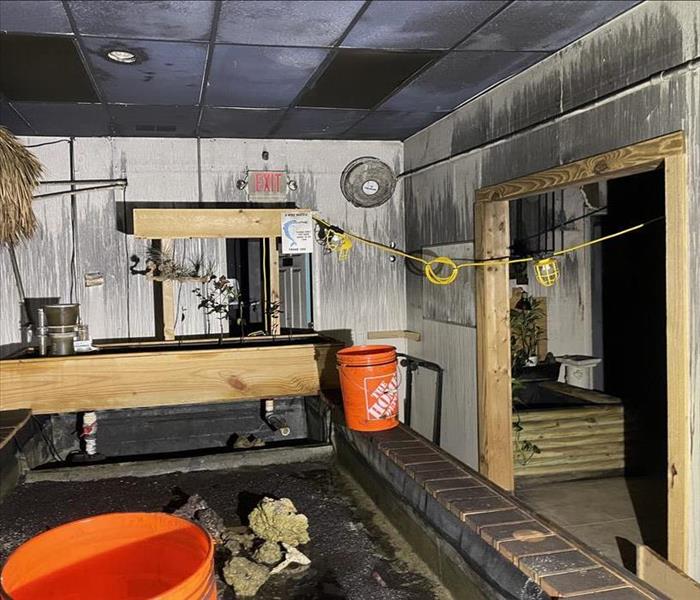 In this blog, we will explore essential best practices for preventing future fire damage in your home.
In this blog, we will explore essential best practices for preventing future fire damage in your home.
Preventing fire damage is crucial for the safety and well-being of your home and family. While fire damage restoration experts like SERVPRO® can help restore your property after a fire incident, implementing best practices for fire prevention is the most effective way to protect your home. In this blog, we will explore essential best practices for preventing future fire damage in your home. By following these practices, you can minimize the risk of fire, safeguard your property, and avoid the need for extensive fire damage restoration and remediation efforts.
Install Smoke Alarms
Equipping your home with working smoke alarms is essential for early fire detection. Install smoke alarms on every level of your home, including inside bedrooms and outside sleeping areas. Regularly test and replace the batteries in these alarms to ensure they are functioning correctly. Smoke alarms can provide vital early warning signals that can save lives and minimize property damage in the event of a fire.
Practice Safe Cooking Habits
Cooking-related fires are a common cause of residential fires. To prevent fire damage in the kitchen, maintain safe cooking habits such as:
- Never leave cooking unattended, especially when using stovetops or ovens.
- Keep flammable materials, such as kitchen towels, away from open flames.
- Clean cooking surfaces regularly to remove built-up grease and prevent grease fires.
- Have a fire extinguisher readily available in the kitchen and know how to use it properly.
Exercise Caution with Heating Systems
Heating systems, such as fireplaces, wood-burning stoves, and space heaters, require careful use to prevent fire damage. Follow these guidelines:
- Keep flammable materials at least three feet away from heating equipment.
- Use sturdy screens to prevent embers from escaping fireplaces.
- Properly maintain and clean chimneys and flues for efficient and safe operation.
- Turn off space heaters before leaving the room or going to bed.
Handle Electrical Appliances and Cords Safely
Electrical malfunctions and improper handling of appliances can lead to devastating fires. To prevent fire damage related to electrical issues, practice these precautions:
- Do not overload electrical outlets or extension cords.
- Replace frayed or damaged cords and wires promptly.
- Unplug appliances when not in use or when you leave the house.
- Use surge protectors to safeguard sensitive electronics.
Be Mindful of Candle Usage
Candles can create a cozy atmosphere, but they pose a fire risk if not used safely. Consider these precautions when using candles:
- Never leave candles unattended or within reach of children or pets.
- Place candles in sturdy holders on stable surfaces away from flammable materials.
- Blow out candles before leaving a room or going to sleep.
Develop a Fire Escape Plan
Having a well-thought-out fire escape plan is essential for every household. Create a plan that includes multiple escape routes, a designated meeting point outside the home, and the practice of regular fire drills. Ensure that all family members are familiar with the plan and know how to exit the home safely in case of a fire.
Keep Fire Safety Equipment Accessible
To prevent fire damage, it is vital to have the necessary fire safety equipment readily available. Maintain functional fire extinguishers on each level of your home, especially in high-risk areas like the kitchen, garage, and workshop. Additionally, ensure that fire extinguishers are easily accessible and regularly checked for proper functionality.
Preventing future fire damage in your home requires proactive measures and adherence to best practices. By installing and maintaining smoke alarms, practicing safe cooking habits, exercising caution with heating systems, handling electrical appliances and cords safely, being mindful of candle usage, developing a fire escape plan, and keeping fire safety equipment accessible, you can significantly reduce the risk of fire incidents. While fire damage restoration experts like SERVPRO are prepared to assist in the aftermath of a fire, prevention remains the most effective approach to protect your home and loved ones. Adopt these best practices for fire prevention, and enjoy the peace of mind that comes with knowing you have taken proactive steps to safeguard your home from the devastating effects of fire.
Black Mold: Myths vs. Facts
3/13/2024 (Permalink)
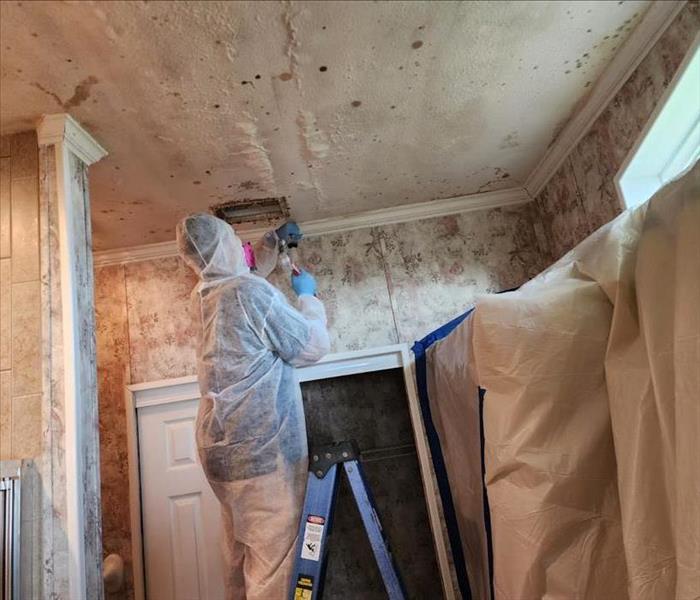 In this blog, we will explore common myths surrounding black mold and provide factual information to dispel any misconceptions.
In this blog, we will explore common myths surrounding black mold and provide factual information to dispel any misconceptions.
Black mold, also known as Stachybotrys chartarum, is a type of mold that has gained attention and generated various myths over the years. It is important to separate fact from fiction when it comes to this form of mold. In this blog, we will explore common myths surrounding black mold and provide factual information to dispel any misconceptions.
Myth 1: All Black Mold is Toxic
Not all black molds are inherently toxic. The term "black mold" is often used to refer to Stachybotrys chartarum specifically. While this particular mold can produce mycotoxins, it is essential to recognize that not all black molds are toxic. The color alone is not an indicator of toxicity. Professional assessment and testing can help determine the species and potential risks associated with mold in your home.
Myth 2: Black Mold is Always Visible
Black mold can certainly be visible on surfaces, presenting as a dark black or greenish-black growth. However, it can also grow in hidden areas, such as behind walls, inside ductwork, or under carpets. Just because you do not see black mold, it does not mean you are immune from its presence and potential damage. Musty odors or unexplained health symptoms may indicate hidden mold growth.
Myth 3: Bleach Can Effectively Eliminate Black Mold
While bleach can help remove mold stains on non-porous surfaces, it is not an effective solution for eliminating black mold entirely. Bleach is mostly water, and when applied to porous materials like drywall or wood, it can actually promote mold growth by providing moisture. Moreover, bleach cannot penetrate deeply into materials, making it ineffective in addressing hidden or deeply rooted mold growth. Professional mold restoration services are recommended for effective black mold removal and remediation.
Myth 4: You Can Remove Black Mold Yourself
Small mold outbreaks on non-porous surfaces may be safely addressed by homeowners with appropriate protective gear and cleaning agents. However, black mold remediation is a complex process that may require professional assistance. Trained professionals have the expertise, experience, and specialized equipment to handle black mold effectively. They can thoroughly assess the situation, contain the affected area, safely remove mold, and address the underlying causes to prevent further growth.
Myth 5: Once Black Mold is Removed, It Will Not Return
Completely eliminating black mold requires more than just removing visible growth. It is crucial to address the underlying source of moisture to prevent its return. Without identifying and rectifying the moisture problem, black mold is likely to resurface. Professionals specializing in mold restoration services can not only remove black mold but also implement preventive measures to minimize the risk of its recurrence.
Separating myths from facts about black mold is essential for homeowners dealing with mold damage. Understanding the misconceptions surrounding black mold can help you make informed decisions and take appropriate actions to safeguard your home. While black mold can be a serious issue, it is important to consult with professionals like SERVPRO® who offer specialized mold restoration services. Their expertise and proven solutions ensure that black mold is effectively eliminated, and preventive measures are implemented to restore and protect your home.
5 Tips to Master Water Extraction
1/24/2024 (Permalink)
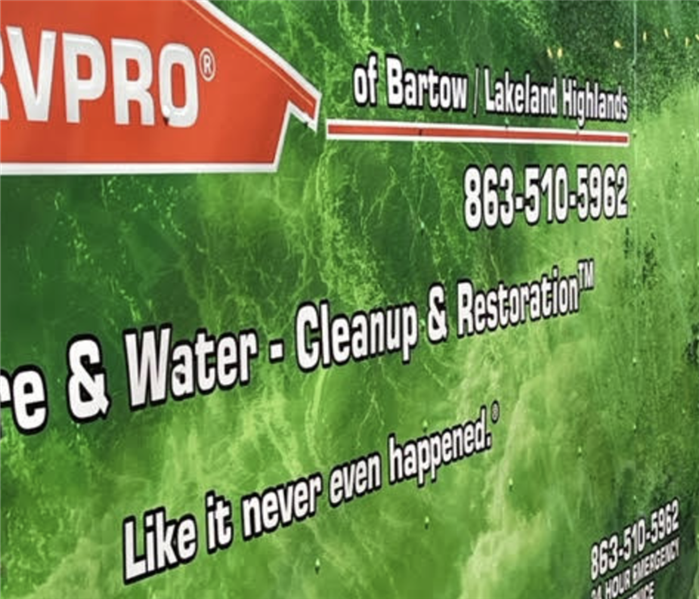 By partnering with our SERVPRO® team, homeowners and businesses can minimize damage and facilitate a faster restoration process!
By partnering with our SERVPRO® team, homeowners and businesses can minimize damage and facilitate a faster restoration process!
Water damage incidents can be overwhelming. To mitigate potential harm to properties, quick and effective water extraction is needed. At SERVPRO®, we've compiled five essential tips for successful water extraction that can assist homeowners and businesses in navigating water emergencies.
1. Act Quickly and Safely
Time is critical when addressing water damage. Act quickly to prevent further damage and other potential hazards. Prioritize safety by shutting off electrical sources and ensuring a safe environment before initiating any water extraction.
2. Assess the Situation
Before initiating water extraction, assess the extent and severity of the damage. Identify the water source and categorize the water damage (clean water, grey water, or black water) to determine the appropriate extraction and restoration methods.
3. Utilize Proper Equipment
Invest in or hire professional-grade equipment suitable for water extraction. Tools like pumps, wet vacuums, dehumidifiers, and air movers are essential for efficient water removal and drying processes. Ensure proper training or professional assistance for using this equipment.
4. Begin Extraction and Drying Immediately
Commence water extraction as soon as possible to prevent further damage and mold growth. Remove standing water using pumps or wet vacuums, and employ dehumidifiers and air movers to facilitate quick drying. Focus on thorough extraction to prevent lingering moisture.
5. Seek Professional Assistance
For extensive or severe water damage situations, seek professional help from restoration experts like SERVPRO of Bartow/Lakeland Highlands. Trained professionals possess the expertise, equipment, and experience necessary for comprehensive water extraction and restoration, ensuring thorough cleanup and minimizing future issues.
Why Trust SERVPRO® for Water Extraction?
- Swift Response: Our 24/7 emergency service ensures immediate response to mitigate water damage, utilizing advanced equipment for efficient extraction and restoration.
- Expertise and Efficiency: With extensive experience in water damage restoration, our professionals deliver effective solutions, ensuring thorough extraction and preventing further damage.
- Comprehensive Restoration: We offer complete restoration services, not just extraction, ensuring properties are restored to their pre-damaged state efficiently.
Successful water extraction is crucial in mitigating the impact of water damage. By following these tips and partnering with professionals like our SERVPRO® team, homeowners and businesses can navigate water extraction effectively, minimizing damage and facilitating a faster restoration process!
5 Common Damages You Can Expect After a Storm
1/8/2024 (Permalink)
 Understanding the most common storm damage repairs is crucial for homeowners to quickly address issues and prevent further damage.
Understanding the most common storm damage repairs is crucial for homeowners to quickly address issues and prevent further damage.
Storms can leave behind a trail of destruction, causing various types of damage to homes and properties. Understanding the most common storm-related repairs is crucial for prompt restoration and maintaining the structural integrity of your property. Below is a list of the top five common storm damage repairs you need to know about.
Roof Repair and Replacement
Roofs often bear the brunt of storm damage, experiencing leaks, missing shingles, or structural issues due to high winds and heavy rains. Promptly addressing roof damage is essential to prevent further water infiltration and structural deterioration. Professional inspection and repairs, including shingle replacement or complete roof restoration, are crucial for protecting your home from further damage.
Water Damage Restoration
Flooding, whether from heavy rains or burst pipes due to freezing temperatures, can cause extensive water damage to homes. Water infiltration can lead to weakened structures, mold growth, and damage to belongings. Professional water damage restoration services are essential to extract water, dry affected areas, and mitigate further damage to prevent long-term issues.
Window and Door Repairs
High winds and flying debris during storms can damage windows and doors, compromising the security and energy efficiency of your home. Repairing or replacing broken windows, damaged frames, or compromised door structures is crucial for maintaining safety and preventing further weather-related issues.
Siding and Exterior Repairs
Siding is susceptible to damage from hail, debris impact, or strong winds during storms. Damaged siding not only affects the aesthetic appeal of your home but also compromises its weatherproofing. Repairing or replacing damaged siding ensures proper insulation and protection against the elements.
Electrical System Restoration
Storms can cause power outages, electrical surges, or damage to electrical systems, posing fire hazards and risking the functionality of appliances and devices. Professional evaluation and repairs of electrical wiring, outlets, and appliances are necessary to restore safety and functionality.
Understanding the most common storm damage repairs is crucial for homeowners to quickly address issues and prevent further damage. At SERVPRO of Bartow/Lakeland Highlands, we specialize in storm damage restoration services, offering expertise and prompt assistance to restore your property to its pre-storm condition. Don't hesitate to seek professional help for efficient and effective storm damage repairs!
Top 5 Things That Should Be Replaced, Not Cleaned, After Fire Damage
12/16/2023 (Permalink)
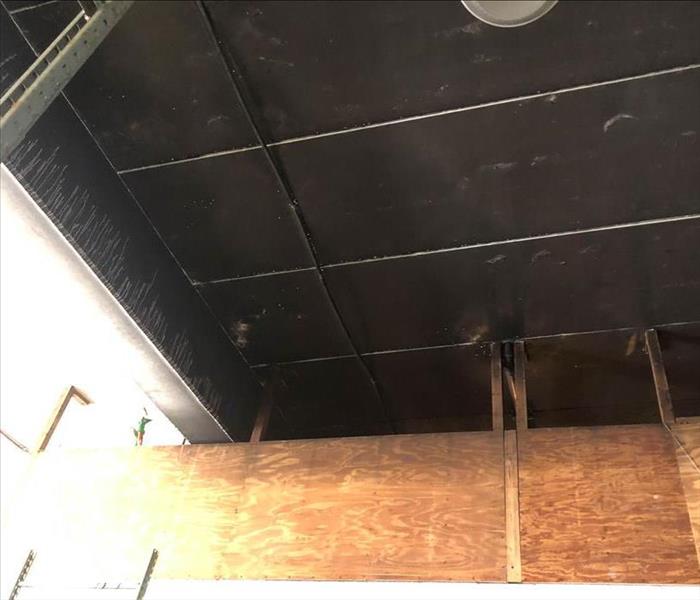 When faced with the aftermath of a fire, it's important to make informed decisions about what to clean and what to replace.
When faced with the aftermath of a fire, it's important to make informed decisions about what to clean and what to replace.
Fire damage can be devastating, leaving behind charred remnants and lingering odors. While it's essential to restore your property as quickly as possible, there are some items that are best replaced, rather than attempting to clean and salvage. In this blog, we'll discuss the top 5 things that should be replaced after fire damage, ensuring the safety, cleanliness, and efficiency of your home or business.
Insulation
Insulation is often one of the first things to consider replacing after a fire. Even if it doesn't appear damaged on the surface, it can absorb smoke and soot, which can release harmful particles into the air over time. Replacing insulation is crucial for maintaining indoor air quality and preventing health issues. Consult with a professional to determine the extent of the damage and the type of insulation that best suits your needs.
Drywall
Drywall is another item that is often better replaced than cleaned after a fire. Smoke and soot particles can penetrate the drywall, making it difficult to completely remove the odors and stains. Replacing affected drywall is a more effective way to eliminate the visual and olfactory reminders of the fire. Be sure to consult with a professional for proper removal and installation to ensure the job is done correctly.
Electrical Wiring and Components
Fire damage can weaken electrical systems and create a significant safety hazard. Damaged wiring and electrical components should be replaced to avoid the risk of electrical fires or other hazards. An electrician should inspect the system thoroughly to identify and replace damaged wiring, outlets, switches, and circuit breakers. This is crucial for the safety of your property and its occupants.
Carpet and Flooring
Carpets and flooring materials can trap smoke and soot particles, making them difficult to clean thoroughly. Even if they appear undamaged, the odors can linger, affecting indoor air quality. Replacing carpets and flooring is a more effective way to ensure a fresh and clean environment. Consider non-porous flooring options like tile or laminate for added durability and ease of maintenance.
HVAC Ductwork
Your HVAC (Heating, Ventilation, and Air Conditioning) system can spread smoke and soot throughout your property if not properly cleaned or replaced. After a fire, it's essential to have your HVAC ductwork inspected and cleaned by professionals. In some cases, replacing the ductwork might be the most effective solution to prevent the circulation of harmful particles throughout your home.
When faced with the aftermath of a fire, it's important to make informed decisions about what to clean and what to replace. Some items, like insulation, drywall, electrical components, carpet and flooring, and HVAC ductwork, are often better off being replaced to ensure the safety, hygiene, and efficiency of your property. It's crucial to consult with professionals to assess the extent of the damage and provide the best solutions for your specific situation. Rebuilding after a fire can be a challenging process, but with the right guidance, you can restore your property to its former glory and create a safe and welcoming environment once again.
The Impact Mold Has on Indoor Air Quality
11/14/2023 (Permalink)
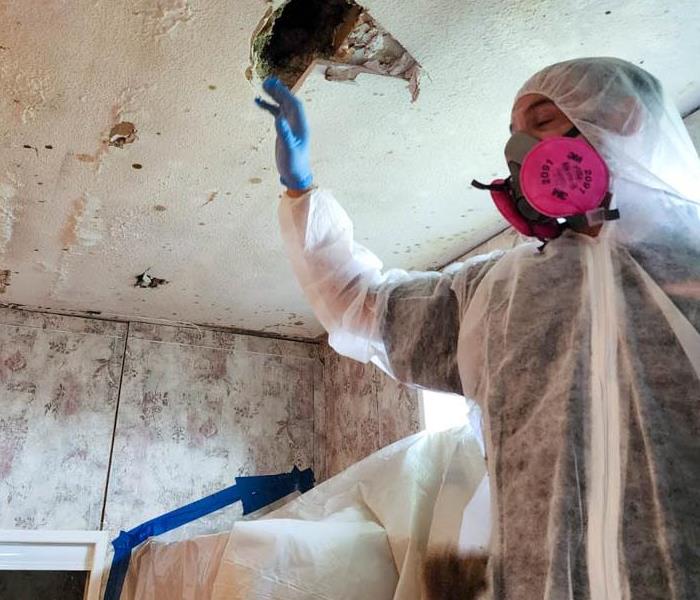 If you suspect mold in your home, it's crucial to have a professional mold inspection.
If you suspect mold in your home, it's crucial to have a professional mold inspection.
In Lakeland Highlands, a region known for its high humidity, the air you breathe at home plays a significant role in your overall well-being. One often underestimated factor affecting the quality of indoor air is the presence of mold. In this blog, we delve into the critical issue of mold and its profound impact on indoor air quality, shedding light on how it can affect your daily life and offering solutions for a better living environment.
Understanding Mold
Mold is a type of fungus that flourishes in damp, humid conditions. Lakeland Highlands' climate makes it highly susceptible to mold growth. Mold spores are everywhere, but when they find the right conditions, they can rapidly multiply, posing challenges to indoor air quality.
Impact on Indoor Air Quality
Mold contamination can result in significantly reduced indoor air quality. The presence of mold can make the air feel heavy and musty, impacting your overall comfort in your home. Mold emits a distinctive, unpleasant, and pervasive musty odor. This odor can linger in your living spaces, affecting your quality of life. Eliminating this odor often requires professional remediation to eradicate the source of the mold problem effectively.
Beyond its impact on air quality, mold can cause significant structural damage to your home. It thrives on porous materials like wood, drywall, and insulation. Over time, mold can weaken these materials, leading to expensive repairs and compromises in the structural integrity of your property.
Prevention and Remediation
Effective mold prevention hinges on managing moisture. Ensure your home is well-ventilated and free from water leaks. Regularly inspect and promptly address any areas where moisture can accumulate. Routinely cleaning and maintaining your home can also help prevent mold growth. Focus on high-humidity areas like bathrooms, kitchens, and basements. Reducing humidity and maintaining cleanliness are essential for minimizing mold's impact on indoor air quality.
If you suspect mold in your home, it's crucial to have a professional mold inspection. Experts can identify the extent of the issue and recommend appropriate remediation methods. SERVPRO® of Bartow/Lakeland Highlands is your local specialist for mold remediation and restoration, ensuring clean, mold-free living space.
Mold can significantly impact the air quality and the integrity of your home. Taking preventative measures, regular cleaning, and seeking professional help when needed are crucial steps in maintaining high indoor air quality. For any mold-related concerns in Lakeland Highlands, contact SERVPRO® for help!
Protecting Your Important Documents from Water Damage
10/9/2023 (Permalink)
Living in the beautiful state of Florida comes with its fair share of water-related risks, from heavy rains and flooding to the occasional hurricane. Protecting your important documents from potential water damage should be a priority for every Florida resident. In this blog, we'll explore practical steps you can take to safeguard your valuable documents and keep them safe and dry.
Identify and Prioritize Important Documents
Start by identifying which documents are crucial and need protection. These may include birth certificates, passports, Social Security cards, wills, insurance policies, property deeds, and financial records. Make a list of these documents to ensure nothing important is overlooked.
Utilize Waterproof Containers
Invest in waterproof containers or document bags designed to withstand water exposure. These containers are essential for protecting your documents from unexpected water disasters. Store your important papers in these containers to create a reliable barrier against water damage.
Create Digital Copies
In addition to physical copies, consider digitizing your important documents. Scan them and store them on a secure cloud service or an external hard drive kept in a waterproof container. This ensures that even if the physical documents are damaged, you have accessible digital backups.
Secure a Safe or Safety Deposit Box
For an extra layer of protection, consider storing your most critical documents in a home safe or a safety deposit box at your bank. These secure options can safeguard your valuables against both water and theft.
Regularly Update and Review Documents
As your life circumstances change, so do your important documents. Regularly update your documents and review them to ensure they reflect your current situation. This includes updating beneficiaries, addresses, and contact information.
Consult with a Professional Restoration Service
In the unfortunate event of water damage to your important documents, contact a professional restoration service like SERVPRO®. Our experts are trained to restore and recover water-damaged documents, photographs, and other valuable items.
Protecting your valuable documents from water damage in Florida is a proactive step toward safeguarding your future. By following these tips, you can ensure that your important papers remain safe, secure, and accessible, even in the face of unexpected water disasters. For expert assistance with water-damaged documents or property, reach out to SERVPRO®. We're here to help you through challenging times and restore what matters most.


 24/7 Emergency Service
24/7 Emergency Service





